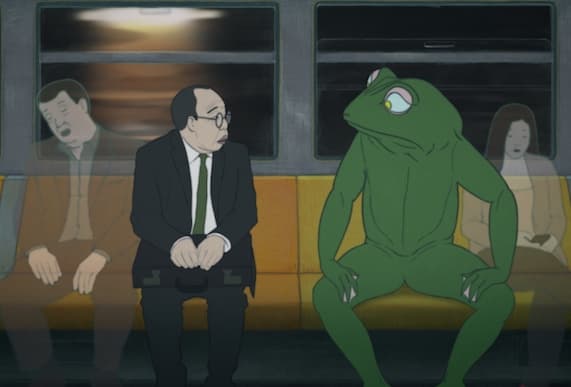Apparently, Convincing Haruki Murakami Was the Director’s Biggest Task
Even though the Japanese writer is said to ‘detest’ animated films, he allowed Pierre Földes to make ‘Blind Willow, Sleeping Woman’ based on his short stories. Was it Földes’s paintings that piqued his interest?

The Japanese writer Haruki Murakami, according to the literature accompanying the new film “Blind Willow, Sleeping Woman,” is a rock star — or at least that’s what the author’s agents told Pierre Földes when he broached the subject of making a movie based on Mr. Murakami’s short stories. Also, unsubstantiated reports labeled the author mercurial and dismissive and said he “detested” animated pictures — which was, alas, Mr. Földes’s intended medium for the project.
All of which would be enough to prompt most filmmakers to shelve their starry-eyed plans. Yet, contrary to Mr. Murakami’s reputation, he took a shine to Mr. Földes or, rather, to the “originality” of his style. Do a quick surf online and you might agree with the author’s turn-around, as Mr. Földes clearly is a renaissance man.
Or maybe he’s just a capable multi-tasker. Born in the United States and raised in Paris, Mr. Földes studied composition and piano, and established himself professionally in New York City as a composer for, among much else, video games and commercials. He’s made a spate of short films, both live action and animated, and is a dab hand in the kitchen. If the photos on his blog are anywhere close to the truth, his Brioche Vendéenne is to die for.
One suspects, though, that it was Mr. Földes’s paintings that piqued Mr. Murakami’s interest. Dreamy, disaffected, and cut with a clinical strain of Surrealism, the pictures posit a world in which isolation is the norm and memories are, at best, a burden. How well this romantic sense of alienation corresponds to Mr. Murakami’s literary vision is a matter I’ll leave to his fan base. In the case of “Blind Willow, Sleeping Woman,” Mr. Földes has crafted a film in which curious goings-on are limned in an appealingly stilted manner.
However much it may have been boosted by CGI, “Blind Willow, Sleeping Woman” retains an old school flavor due to its adamant two-dimensionality and unapologetic dependence on rotoscoping, the method of animation in which tracing is done over live action footage. Mr. Földes makes a point that his picture wasn’t rotoscoped. The animators, he explains rather fuzzily, took “inspiration from the actors, their expressions, rhythm, and movements as the basis for the animation.” Be that as it may, this is a cartoon whose style is altogether appropriate to its narrative and mood.
Six of Mr. Murakami’s stories have, apparently, been molded into “Blind Willow, Sleeping Woman,” but two characters dominate: Komura (Ryan Bommarito) and Katagiri (Marcelo Arroyo). Both men work for the towering Tokyo Security Trust Bank, but how well and for how long is the crux of the film.
Komura is diligent and uninspired — for all intents and purposes, a drone — while Katagiri has bumbled a deal that may cost the bank a significant chunk of money. Their stories don’t overlap so much as bypass each other, but all events take place just a few days past the 2011 earthquake and tsunami. Throughout the film, ghost-like characters — flattened figures rendered gray and filmy — amble through the proceedings. Are these the souls that have been lost to the disaster? Mr. Földes doesn’t elaborate on the matter.
All of which sounds fairly mundane for a movie based on the work of a renowned science fiction writer, but then there’s the human-sized frog that shows up in Katagiri’s apartment asking for assistance in saving Tokyo from assault by a giant worm living under the ocean. As for Komura: He’s tasked with delivering a mysterious small box to a colleague’s sister living in the provinces. Komura has also lost his cat and his wife — the latter of whom has her own side adventure with a reclusive millionaire and a misspent wish.
“Blind Willow, Sleeping Woman” succeeds more in tone than in story, though Mr. Földes does prove remarkably supple in threading the various strands of the plot through the needle. The picture won’t be to everyone’s taste and is definitely not for children. Yet should oddball tangents syncopated to languorous rhythms sound like your cup of post-apocalyptic reverie, then this movie is for you.

